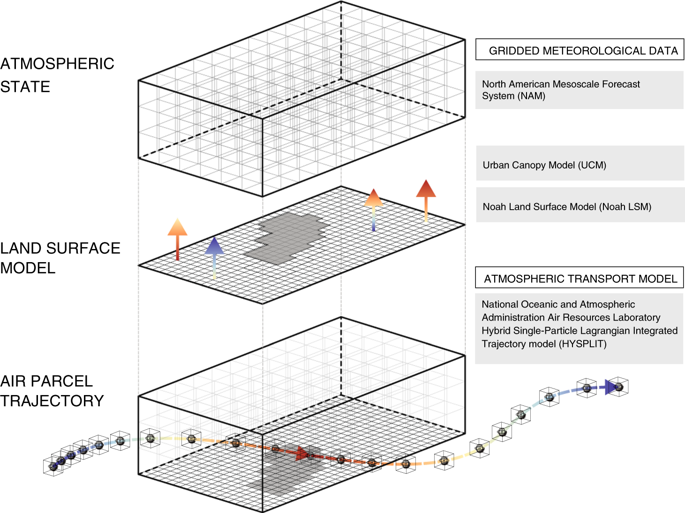npj Climate and Atmospheric Science ( IF 9 ) Pub Date : 2018-12-20 , DOI: 10.1038/s41612-018-0055-3 Ann Cosgrove , Max Berkelhammer

|
The urban heat island (UHI) effect was first documented ~200 years ago, making it the longest recognized anthropogenic effect on climate. Although anomalous heating in cities has been meticulously characterized, less is known about how the UHI affects surrounding regions. It is hypothesized that downwind of cities a “heat plume” forms due to the advection of urban heat. This heat transport may have impacts beyond heating of the surface, such as disrupting atmospheric convection and influencing boundary layer structure, which influences weather, air quality, and human health. Here, a lagrangian atmospheric transport model, forced with archived data from a numerical weather model, is used to generate a three-dimensional map of an urban heat plume for a major city, Chicago. We document significant heating 100–200 m above the surface and 70 km downwind of the city. Over Lake Michigan, the scale of the plume is truncated nearly in half (~40 km), suggesting the lake is acting as a sink for the exported urban heat. Using satellite lake surface temperatures, we observed a disruption of the diurnal pattern of lake temperature beneath the plume, which supports a possible role of the lake in absorbing the heat plume. The results provide unique quasi-observational evidence for a significant footprint of cities on regional atmospheric structure and potentially on adjacent aquatic bodies.
中文翻译:

城市热岛在空气和湖泊温度下的顺风足迹
城市热岛效应(UHI)最早是在200年前被记录下来的,是公认的最长的人为气候效应。尽管已经对城市的异常取暖进行了细致的描述,但人们对UHI如何影响周边地区的了解却很少。据推测,由于城市对流的平流,在顺风城市形成了“热羽”。这种热传递可能不仅影响表面加热,还会产生其他影响,例如破坏大气对流并影响边界层结构,从而影响天气,空气质量和人体健康。在这里,使用拉格朗日大气传输模型,并强制使用来自数字天气模型的存档数据,以生成主要城市芝加哥的城市热羽的三维地图。我们记录到地表以上100-200 m处以及该市下风70公里处有大量采暖。在密歇根湖上,羽状流被截断了近一半(〜40 km),这表明该湖正在充当城市热量输出的汇。利用卫星湖泊表面温度,我们观察到了羽流下方湖泊温度的日变化模式,这支持了湖泊在吸收热羽流中的可能作用。研究结果提供了独特的准观测证据,证明了城市在区域大气结构上以及潜在地在邻近水生生物上的重要足迹。我们观察到了羽流下方湖泊温度的日变化规律,这支持了湖泊在吸收热量羽流中的可能作用。研究结果提供了独特的准观测证据,证明了城市在区域大气结构上以及潜在地在邻近水生生物上的巨大足迹。我们观察到了羽流下方湖泊温度的日变化规律,这支持了湖泊在吸收热量羽流中的可能作用。研究结果提供了独特的准观测证据,证明了城市在区域大气结构上以及潜在地在邻近水生生物上的重要足迹。



























 京公网安备 11010802027423号
京公网安备 11010802027423号